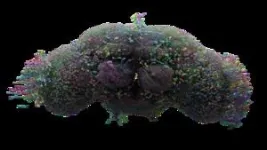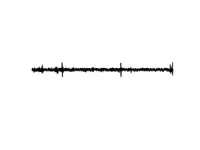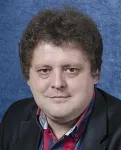(Press-News.org) Love songs are at least as popular in the animal kingdom as on the radio. The importance of musically serenading your true love has driven plotlines from Twelfth Night to The Trumpet of the Swan to Happy Feet.
The latest exploration of music in the natural world is taking place in Mala Murthy’s lab at the Princeton Neuroscience Institute, where Murthy and her research group have used neural imaging, optogenetics, motion capture, modeling and artificial intelligence to pinpoint precisely where and how a fruit fly’s brain toggles between its standard solo and its mating serenade. Their research appears in the current issue of the journal Nature.
“For me it is very rewarding that, in a team of exceptional scientists coming from different backgrounds, we joined forces and methodologies to figure out the key characteristics of a neural circuit that can explain a complex behavior — the patterning of courtship song,” said Frederic Römschied, first author on this paper and a former postdoctoral fellow in Murthy’s lab. He is now a group leader at the European Neuroscience Institute in Göttingen, Germany.
“It might be a surprise to discover that the fruit flies buzzing around your banana can sing, but it’s more than music, it’s communication,” said Murthy, the Karol and Marnie Marcin ’96 Professor and the director of the Princeton Neuroscience Institute. “It’s a conversation, with a back and forth. He sings, and she slows down, and she turns, and then he sings more. He’s constantly assessing her behavior to decide exactly how to sing. They’re exchanging information in this way. Unlike a songbird, belting out his song from his perch, he tunes everything into what she’s doing. It’s a dialogue.”
By studying how these tiny brains work, researchers hope to develop insights that will prove useful in the larger and more complex brains that are millions of times harder to study. In particular, Murthy’s team is trying to determine how the brain decides what behavior is appropriate in which context.
“One of the brain’s most impressive abilities is its capacity to generate patterns of behavior that are appropriate in particular contexts,” said Max Aragon, a fifth-year graduate student in Murthy’s lab. “For example, the way you speak to a group of close friends in a coffee shop is likely very different from the way you speak to relatives at dinner. What is happening in the brain that allows us to generate this behavioral flexibility?”
A fruit fly courtship in song
Similar to crickets and grasshoppers, fruit flies also use their wings to sing, but they extend and vibrate one wing at a time. For Drosophila melanogaster, only the male fruit flies sing. The females respond by moving away or slowing down to allow the male to approach. Male fruit flies can’t force mating; he has to woo her.
“He chases her and sings to her, and she chooses whether or not to slow down for him,” Murthy said. “They’ll go through this dance for 20 minutes or so, until she slows down enough to mate. He’ll sing hundreds of the ‘song bouts’ to her during their courtship.”
The simplest song bouts last only a fraction of a second, and the complex bouts can go on for several seconds.
Murthy played a clip of the fruit fly serenade, amplified thousands of times: a series of pulses intermixed with more musical tones.
“That’s the real song. It’s not slowed down or sped up,” Murthy said. “It’s just so quiet that even if the fruit fly landed in your ear, you wouldn’t hear it. You need to amplify it, because fruit flies have tiny little wings, but that’s it. That’s actually what he’s singing to her.”
The “pulses” are the sounds that the male makes when he’s further away, to get the female’s attention, and the more tuneful serenading that he does up close is the “sine” song. There’s a third mode, “complex,” which flips back and forth between pulse and sine songs.
As he chases and she evades or encourages his approach, the song flickers back and forth between simple pulse-only songs and complex pulse and sine serenades. She seems to like the alternating pattern as well. In the clinical language of academia, the paper says, “Songbout complexity may be desirable to the female, as the majority of bouts immediately preceding copulation are complex.”
Bold bets at Princeton on curiosity-driven research
Several Princeton resources contributed to answering the question. The team used LEAP (LEAP Estimates Animal Pose) and its next generation SLEAP (Social LEAP Estimates Animal Poses), both deep-learning-based motion-capture tools developed by a previous Princeton collaboration, that quantified exactly how the flies are moving and where they are in relation to each other. In addition, the neural imaging of the flies was performed at the endowment-funded Bezos Center for Neural Circuit Dynamics.
“Princeton is a special place that encourages collaboration between scientists with diverse expertise, from computational neuroscience to physics and beyond,” Aragon said. “PNI in particular is a relatively small institute, so there’s a good chance of running into someone with a great idea that happens to exactly solve a problem you’ve been facing in your work.”
“Being at Princeton, working with Mala Murthy, created an extremely supportive atmosphere, where novel ideas were always encouraged, and the path from idea to experiment was free from bureaucratic hurdles,” agreed Römschied.
Using SLEAP, the researchers showed that the key cause for the switch between solo mode and serenade mode was proximity — how close together the male and female fruit flies were.
“Our work uncovered a toggle switch in his brain,” Murthy said. “When the switch is engaged, he can sing a beautiful, long song, and then immediately, as he separates from her just a little bit, the switch disengages, and he’s just singing one simple song. We showed that this one neural circuit operates in two regimes via the switch. You don’t need a separate circuit to generate a different song. This had not been shown before.
“I love the idea of a circuit that toggles between regimes,” she continued. “It’s just so simple. You don’t have to keep making new circuits for every new behavior. It’s such a nice, elegant solution.”
“Flexible circuit mechanisms for context-dependent song sequencing,” by Frederic A. Römschied, Diego A. Pacheco, Max J. Aragon, Elise C. Ireland, Xinping Li, Kyle Thieringer, Rich Pang and Mala Murthy, appears in the Oct. 11 issue of Nature (DOI: 10.1038/s41586-023-06632-1) and was supported by the Bezos Center for Neural Circuit Dynamics at the Princeton Neuroscience Institute, the German Research Foundation (DFG Forschungsstipendium RO 5787/1-1 and RO 5787/2-1 to F.A.R.), the Sloan-Swartz Foundation to R.P., the Howard Hughes Medical Institute (Faculty Scholar Award to M.M.), the NIH BRAIN Initiative (NS104899 to M.M.), and an NIH NINDS R35 Research Program Award to M.M.
END
Fruit fly serenade: Princeton neuroscientists decode their tiny mating song
Princeton's 'extremely supportive atmosphere' for new ideas laid the foundation for an aha moment about a toggle-switch in the fruit fly brain. Do humans have one, too?
2023-10-11
ELSE PRESS RELEASES FROM THIS DATE:
Experiencing record-breaking heat days affects perception of weather trends
2023-10-11
PHILADELPHIA -- New research published by a team at the Annenberg Public Policy Center of the University of Pennsylvania finds that experiencing days in which the temperature exceeds previous highs for that time of year affects people’s perception of weather trends.
Published in Scientific Reports, the study “Record-breaking Heat Days Disproportionately Influence Heat Perceptions” finds that living in an area with record-breaking heat effectively increases perceptions that the weather is getting hotter. The research was co-authored by economist Timothy Hyde, a postdoctoral fellow in APPC’s Science of Science Communication Division, and psychologist and communication ...
Aston University researcher named in Photonics top 100
2023-10-11
Aston University professor named in international Top 100 of Photonics
Professor Igor Meglinski’s research overlaps engineering and health sciences
He applies his photonics knowledge to develop methods to detect diseases such as dementia and cancer.
An Aston University professor has been named in an international Top 100 of Photonics key players.
Igor Meglinski, professor in quantum bio-photonics and biomedical engineering was elected by fellow experts as one of the Top 100 in the field of photonics – the science and technology of light.
Although he is based in the College ...
Novel biomaterial delivers medication directly to fish gut
2023-10-11
A novel biomaterial developed at the Federal University of São Paulo (UNIFESP) in Brazil can help solve two problems at once. As a bioparticle, it can act as a drug carrier, delivering medication directly to the gastrointestinal tract of fish in order to circumvent resistance to conventional antibiotics, for example. In addition, it is administered orally in powder form and is highly palatable to fish, increasing the probability of effective treatment while at the same time reducing the waste ...
$15.4 million grant to help eliminate health disparities in Indiana
2023-10-11
INDIANAPOLIS—A new $15.4 million grant will help Indiana University School of Medicine recruit and educate medical students to better care for underserved populations, in hopes of improving health care across Indiana.
The Health Resources & Services Administration (HRSA) grant will provide about $4 million over four years to the Indiana Primary Care Advancement in Clinical Training (INPACT) program. The goal of the program is to recruit more students from medically underserved areas of the state and provide doctors with the tools ...
Aerovy, an advanced air mobility software provider, completes $800,000 pre-seed funding round
2023-10-11
WEST LAFAYETTE, Ind. – Aerovy, a Purdue University-connected startup, has completed a round of funding and is expanding industry partnerships around the world. Aerovy develops cloud-based software solutions for the advanced air mobility, or AAM, sector, which includes electric-powered urban and regional aircraft.
CEO Nick Gunady said Aerovy has closed its round of pre-seed funding, raising $800,000 from Purdue Innovates, M25 and the Flywheel Fund.
“The closing of the pre-seed round represents a critical milestone in our missions to unlock the energy ...
Absorption of light by molecules has applications in microscopy, medicine and data storage
2023-10-11
Absorption spectroscopy is an analytical chemistry tool that can determine if a particular substance is present in a sample by measuring the intensity of the light absorbed as a function of wavelength. Measuring the absorbance of an atom or molecule can provide important information about electronic structure, quantum state, sample concentration, phase changes or composition changes, among other variables, including interaction with other molecules and possible technological applications.
Molecules with a high probability of simultaneously absorbing ...
SwRI’s Dr. Nicholas Mueschke named AIAA Associate Fellow
2023-10-11
SAN ANTONIO — October 11, 2023 —Southwest Research Institute’s Dr. Nicholas Mueschke has been named an Associate Fellow of the American Institute of Aeronautics and Astronautics (AIAA).
AIAA Associate Fellows are recognized for overseeing important engineering or scientific work and outstanding contributions to their field. Associate Fellows must be recommended by at least three other associate fellows, be a senior member in good standing of the AIAA and have at least 12 years of professional experience. AIAA selects only one Associate Fellow for each 150 members each year.
The AIAA selected Mueschke for ...
New research finds greater continuity of psychotherapy after shift to telehealth
2023-10-11
WASHINGTON, D.C., Oct. 11, 2023 — The rapid transition to virtual care that occurred with the onset of the COVID-19 pandemic resulted in better continuity of psychotherapy visits compared to prior to the pandemic when almost all visits were in-person, according to new research published in Psychiatric Services, a journal of the American Psychiatric Association. In addition, the time between appointments grew shorter after the transition to virtual care. The study results highlight the benefits of continued availability of virtual psychotherapy.
This ...
Newsmakers: Basic research findings by Johns Hopkins scientists focus on gene sequencing, hearing loss and a brain disorder
2023-10-11
FOR IMMEDIATE RELEASE
Yes, Scientists Have Sequenced the Entire Human Genome, But They’re Not Done Yet
The human genome, from end to end, has been sequenced, meaning scientists worldwide have identified most of the nearly 20,000 protein-coding genes. However, an international group of scientists notes there’s more work to be done. The scientists point out that even though we have nearly converged on the identities of the 20,000 genes, the genes can be cut and spliced to create approximately 100,000 proteins, and gene experts are far from agreement on what those 100,000 proteins are.
The group, which convened last fall at Cold Spring Harbor Laboratory in New York, has now ...
Icahn School of Medicine at Mount Sinai and the University of California San Diego receive $8.5 million award to establish a data integration hub for NIH Common Fund supported programs
2023-10-11
New York, NY [October 11, 2023]—Researchers at the Icahn School of Medicine at Mount Sinai and the University of California San Diego have been awarded an $8.5 million grant to create a data integration hub aimed at accelerating novel therapeutics and cures for diseases within initiatives supported by the National Institutes of Health (NIH) Common Fund.
NIH Common Fund programs are large-scale projects designed to collect cutting-edge biomedical research data from human cells, tissues, and patients to rapidly ...
LAST 30 PRESS RELEASES:
Numbers in our sights affect how we perceive space
SIMJ announces global collaborative book project in commemoration of its 75th anniversary
Air pollution exposure and birth weight
Obstructive sleep apnea risk and mental health conditions among older adults
How talking slows eye movements behind the wheel
The Ceramic Society of Japan’s Oxoate Ceramics Research Association launches new international book project
Heart-brain connection: international study reveals the role of the vagus nerve in keeping the heart young
Researchers identify Rb1 as a predictive biomarker for a new therapeutic strategy in some breast cancers
Survey reveals ethical gaps slowing AI adoption in pediatric surgery
Stimulant ADHD medications work differently than thought
AI overestimates how smart people are, according to HSE economists
HSE researchers create genome-wide map of quadruplexes
Scientists boost cell "powerhouses" to burn more calories
Automatic label checking: The missing step in making reliable medical AI
Low daily alcohol intake linked to 50% heightened mouth cancer risk in India
American Meteorological Society announces Rick Spinrad as 2026 President-Elect
Biomass-based carbon capture spotlighted in newly released global climate webinar recording
Illuminating invisible nano pollutants: advanced bioimaging tracks the full journey of emerging nanoscale contaminants in living systems
How does age affect recovery from spinal cord injury?
Novel AI tool offers prognosis for patients with head and neck cancer
Fathers’ microplastic exposure tied to their children’s metabolic problems
Research validates laboratory model for studying high-grade serous ovarian cancer
SIR 2026 delivers transformative breakthroughs in minimally invasive medicine to improve patient care
Stem Cell Reports most downloaded papers of 2025 highlight the breadth and impact of stem cell research
Oxford-led study estimates NHS spends around 3% of its primary and secondary care budget on the health impacts of heat and cold in England
A researcher’s long quest leads to a smart composite breakthrough
Urban wild bees act as “microbial sensors” of city health.
New study finds where you live affects recovery after a hip fracture
Forecasting the impact of fully automated vehicle adoption on US road traffic injuries
Alcohol-related hospitalizations from 2016 to 2022
[Press-News.org] Fruit fly serenade: Princeton neuroscientists decode their tiny mating songPrinceton's 'extremely supportive atmosphere' for new ideas laid the foundation for an aha moment about a toggle-switch in the fruit fly brain. Do humans have one, too?






